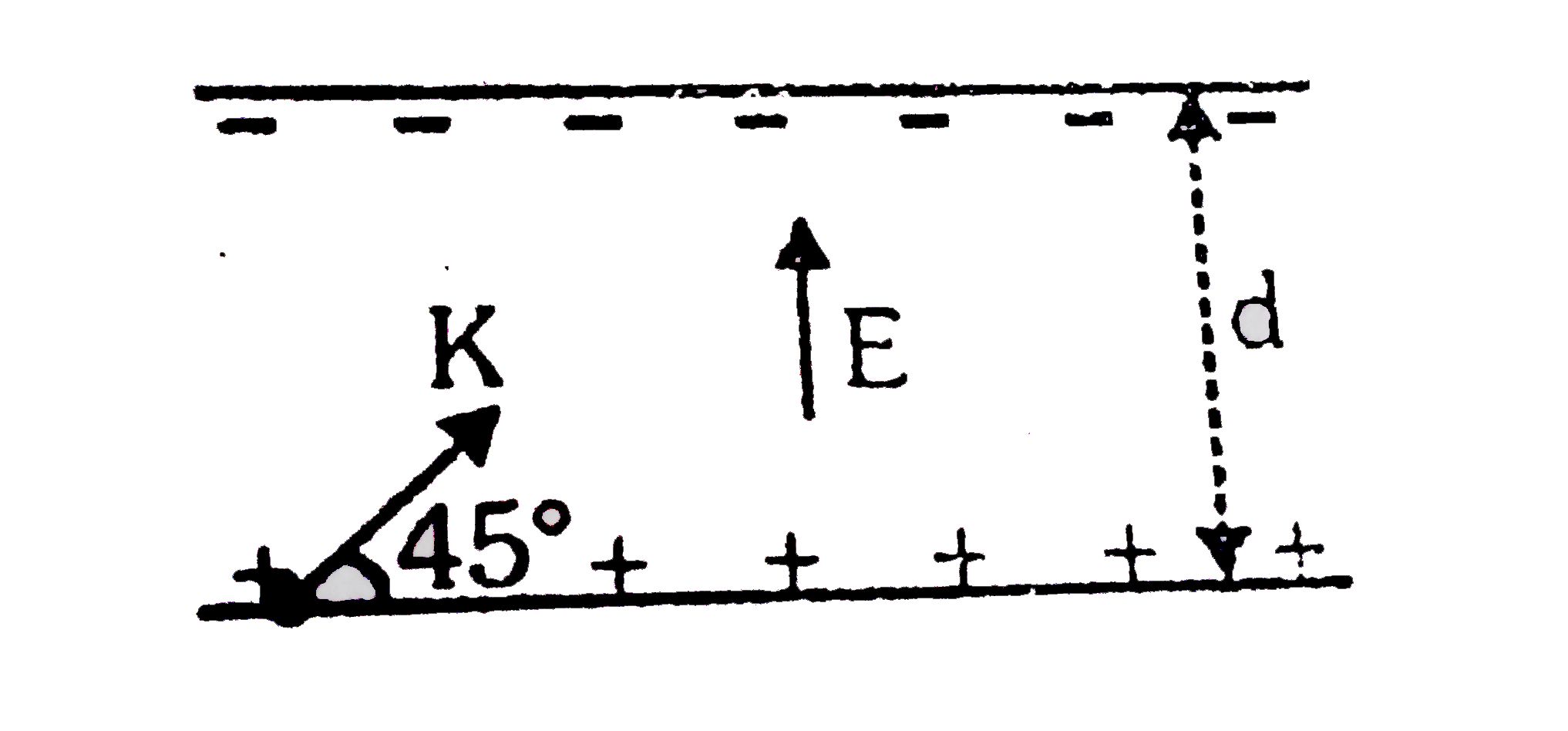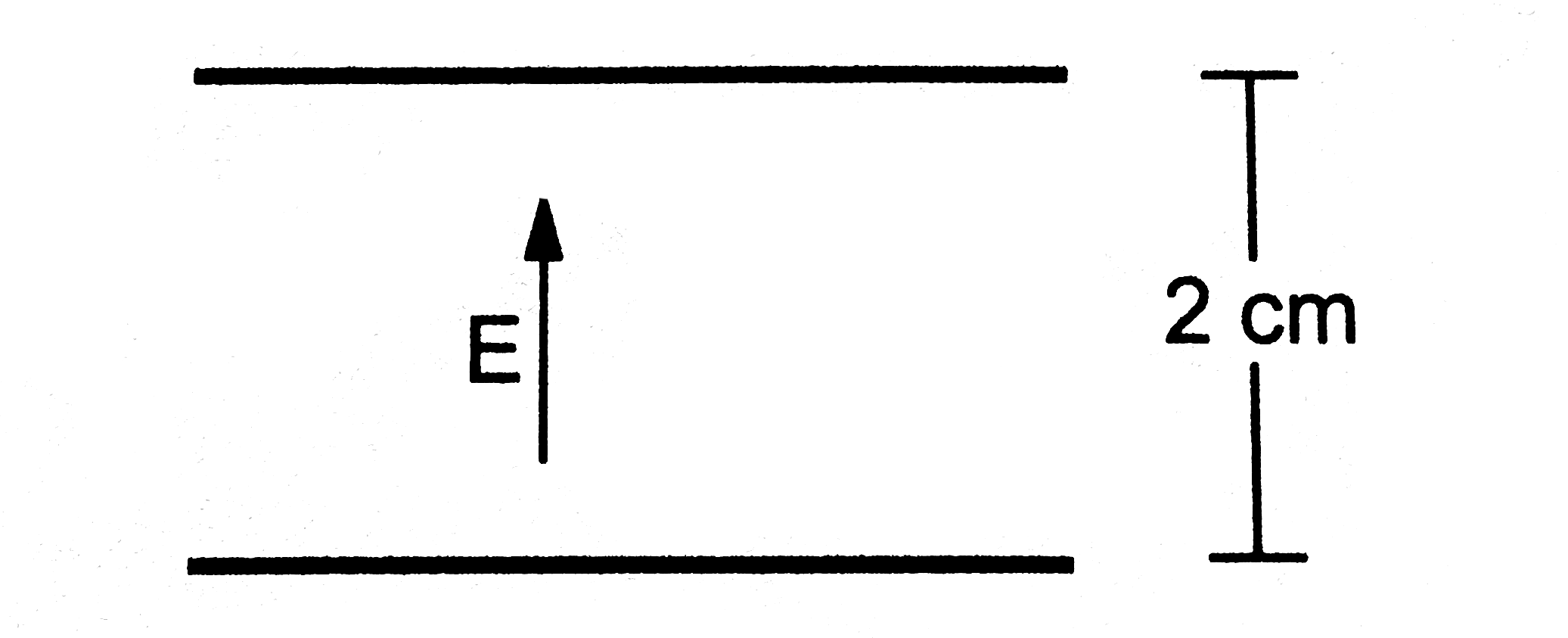An electron is projected as in figure with kinetic energy K, at an angle θ=45∘ between two charged plates. The magnitude of the electric field so that the electron just fails to strike the upper plate, should be greater than:
 Solution in Gujrati
Solution in Gujrati
Kqd
2Kqd
K2qd
iInifinite
The correct Answer is:C
If particle will loose KE (in that direction) against work done by electric field K2=qEd⇒E=K2qd
Topper's Solved these Questions
- MISCELLANEOUSBOOK - ALLEN CHAPTER - MISCELLANEOUSEXERCISE - Exersice-03
7 Videos
- MISCELLANEOUSBOOK - ALLEN CHAPTER - MISCELLANEOUSEXERCISE - ASSERTION-REASON
18 Videos
- MISCELLANEOUSBOOK - ALLEN CHAPTER - MISCELLANEOUSEXERCISE - Part -II Example Some worked out Examples
1 Videos
- KINEMATICS (MOTION ALONG A STRAIGHT LINE AND MOTION IN A PLANE)BOOK - ALLEN CHAPTER - KINEMATICS (MOTION ALONG A STRAIGHT LINE AND MOTION IN A PLANE)EXERCISE - BEGINNER S BOX-7
8 Videos
- PHYSICAL WORLD, UNITS AND DIMENSIONS & ERRORS IN MEASUREMENT BOOK - ALLEN CHAPTER - PHYSICAL WORLD, UNITS AND DIMENSIONS & ERRORS IN MEASUREMENT EXERCISE - EXERCISE-IV
7 Videos
Similar Questions
Column IColumn II(A)1fermi(p)10−13m(B)1X-ray unit(q)10−15m(C)1angstrom(r)10−10m(D)1Astronomical unit(s)9.46×1015m(E)1Light year(t)3.26Light year(F)1Parse(u)3.08×1016m(v)1.49×1011m
View SolutionStatement 1: whenevever the unit of measurement of a quantity is changed, its numerical value changes.
and
Statement -2 : Smaller the unit of measurement smaller is its numerical value.
View SolutionFor spherically symmetrical charge distribution, electric field at a distance r from the centre of sphere is →E=kr7→r, where k is a constant. What will be the volume charge density at a distance r from the centre of sphere?
View SolutionA football player kicks a ball at an angle of 30∘ with an initial speed of 20 m/s. Assuming that the ball travels in a vertical plane, calculate (a) the time at which the ball reaches the highest point (b) the maximum height reached (c) the horizontal range of the ball (d) the time for which the ball is in the air, (g=10m/s2)
View SolutionAssertion : Gravitational forces do not depend on the medium between the masses.
Reason : Mediating particle responsible for gravitational force is graviton.
View SolutionAn electric field of magnitude 1000NC−1 is produced between two parallel platees having a separation of 2.0 cm as shown in figure(29.E4) (a) What is the potential difference between the plates? (b) With what minimum speed should an electron be projected from the lower plate in the direction of the field so that it may reach the upper plate? ( c) Suupose the electron is projected from the lower plate with the speed calculated in part (b) . The direction of projection makes an angle of 60∘ with the field. Find the mazimum height reached by the electron.

View SolutionAn electron enters the region between the plates of a parallel plate capacitor at an angle theta to the plates. The plate width is l , the plate separation is d . The electron follows the path shown just missing the upper plate. Neglect gravity. Then,
View SolutionAn electron is projected as shown in fig. with kinetic energy K, at an angle theta=45^(@) between two charged plates. Ignore the gravity. At what distance from the starting point will the electron strike the lower plate?
View SolutionAn electric field E is produced between two parallel plates having a separation d as shown.
(a) With what minimum speed should an electron be projected from the lower plate in the direction of field so that it may reach the upper plate ?
(b) Suppose the electron is projected from the lower plate with the speed calculated in part (a). The direction of projection makes an angle of 60∘with the field. Find the maximum height reached by the electron.
(c ) After how much time , the electron again strikes the lower plate ?
(d) Horizontal distance travelled by the electron in time calculated in part (c).
Charge on electron : e ,mass of electron : m, consider only electric force.
View SolutionAn electron (e,m) is projected into a uniform electric field E vertically downward between parallel plates at separation d , with velocity v_(0) . The electron enters the electric field at a point midway between the plates. Find (a) the magnitude of electric field if electron emerges from the electric field just at the edge of upper plate. (b) the direction of the velocity of electron as it emerges from the electric field. (c ) the equation of trajectory followed by electron. The length of plates is L and consider only electric force.
View SolutionAn electron is projected as shown with speed u . If electron just fails to strike the upper plate, find range. (distance from starting point at which electron strike the lower plate again). Consider only electric force.
View SolutionAn electron (charge = e, mass = m) is projected horizontally into a uniform electric field produced between two oppositely charged parallel plates, as shown in figure. The charge density on both plates is +- sigma C//m^2 and separation between them is d. You have to assume that only electric force acts on the electron and there is no field outside the plates. Initial velocity of the electron is u, parallel to the plates along the line bisecting the gap between the plates. Length of plates is 2L and there is a screen perpendicular to them at a distance L. (i) Find s if the electron hits the screen at a point that is at same height as the upper plate. (ii) Final the angle q that the velocity of the electron makes with the screen while it strikes it.
View SolutionAn electron is projected with an initial velocity of 10^(7)ms^(-1) into an electric field between two parallel plates 1 cm apart. The electron enters the field at a point midway between the plates. If the electron just misses the positivity charged plate as it emerges from the field, find the magnnitude of the electric density between the plates. (Length of each plate is 2 cm, mass of electron= 9xx10^(-31) kg and charge of electron =1.6xx10^(-19) C)
View SolutionFrom what distance should a 100 eV electron be fired towards a large metal plate having a surface charge of -2.0 xx 10^(-6) Cm^(-2) , so that it just fails to strike the plate ?
View Solution[" 0.A electric field of "1.5times10^(4)NC^(-1)" exists "],[" between two parallel plates of length "2cm." An "],[" electron enters the region between the plates "],[" at right angles to the field with a kinetic energy "],[" of "E_(k)=2000eV." The deflection that the "],[" electron experiences at the deflecting plates "],[" is "]
View SolutionAn electron of kinetic energy K is projected between two charged plats at an angle 60^(@) as shown in figure. If electrons doesn't reach to the upper plate just before striking then the magnitude of electric field will be more than:
View Solution
